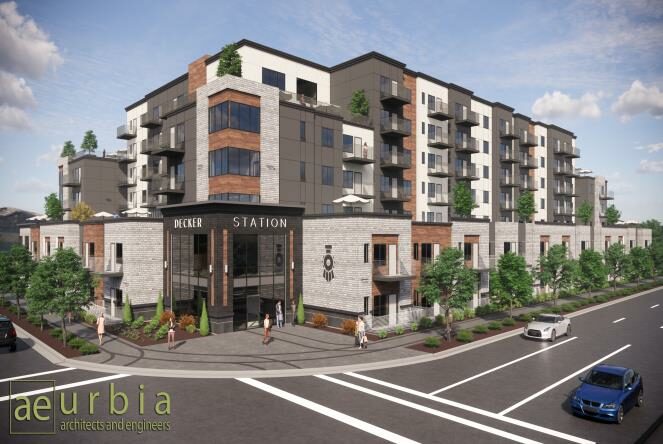Building Utah: The Projects Transforming the State from North to South
It’s springtime and the orange cones are blooming as the weather gets warm enough for construction to begin again in full force. From north to south, the signs of Utah’s strong economy and demand for new facilities are everywhere.
Housing
With Utah’s rapidly growing population, it’s no surprise that apartments and other living facilities top the list of projects in the state.
Several of these projects are being built by Rimrock Construction, including Oquirrh Hills Apartments, a 384,215-square-foot project in Magna, and The Ridge in Sandy, featuring 252 luxury apartments across 281,027 square feet of living space with 152,400 square feet of structured parking. In downtown Salt Lake City, Rimrock is also constructing the Alta Gateway, a luxury apartment complex with 277 units in 289,767 square feet of living space, all wrapped around a 118,570-square-foot parking structure behind The Gateway mall.
Mark Mathews with Rimrock Construction says many developers are asking for nicer housing communities than the bare, utilitarian units that might have done the trick a few years ago—utilitarian is passé.
“The standards for what leases and the standards for what companies want to put out as their product have risen,” he says.
Matthews thinks part of the reason new apartments are getting nicer is because owners are trying to supply what would-be tenants are demanding, especially when it comes to the young, up-and-coming demographic. “A lot is based on what Millennials want—they don’t want to go from living in their parents’ nice homes to a dumpy little apartment, and because you just have a lot of competition, a lot of these apartments are looking for ways to set themselves apart from the others,” he says.
Besides Millennials, another big group companies are catering to are aging Baby Boomers. Rimrock is also building Ashford Assisted Living and Memory Care in Springville, a 69,125-square-foot facility. In Sugarhouse, Big-D Construction is working on Legacy Village, a state-of-the-art senior living facility with six living levels and four parking levels. Developed by the Woodbury Corporation with subcontracting support from Great Salt Lake Electric, Pikus Concrete, Drywall Dynamics, Nicholson and others, the 286-luxury unit project will also feature onsite options for dining, entertainment and medical care.
Apartments aren’t the only living facilities cropping up around the state. In St. George, Dixie State University is getting a new on-campus housing facility, spearheaded by Layton Construction. The 350-unit project will include game rooms, community kitchens, a fitness room, a sand volleyball pit and laundry facilities on every floor. The 90,000-square-foot, $20 million project is scheduled to be completed and ready for students to move in this fall, and has support from subcontractors including Western States Mechanical, Wilkinson Electric and Buddy Boys, Inc., as well as Method Studio, Inc..
Offices
Another major area of growth has been with office space around the state, a reflection of Utah’s red-hot economy. Among Rimrock’s office projects is Lehi Tech Center with 181,327 square feet of Class A office space, another addition to the rapidly rising tech sector in the area.
Also in Lehi, the Traverse Mountain Office Building, a project of Big-D Construction and owned by Traverse Mountain Commercial Venture, LLC, will feature two new four-story buildings with floor-to-ceiling glass on each level to offer workers a panoramic view of the Wasatch Mountains and Utah Lake. The infrastructure will use redundant power and have access to fiber optic connectivity, and will have a sustainable design and operation, with the goal for all offices to be LEED certified with gold and silver ratings.
The campus will have a total of 1.5 million square feet of office space, 400,000 square feet of large-scale retail and 120,000 square feet of small-scale retail and restaurants, as well as a 200-room hotel. Key subcontractors on the project include Rydalch Electric, Gunthers Mechanical, VO Brothers Plumbing and Superior Roofing.
Science and Technology
As Utah’s focus on STEM grows, so does the need for its technical facilities, and the Beehive State’s medical facilities are ever expanding and improving. The BioFire Diagnostics project at the University of Utah Research Park was designed by FFKR Architects and will include both office space and room for research and development. The project broke ground a year and a half ago, but is nearing completion, says Roger Jackson of FFKR.
In Farmington, Layton Construction is building the Farmington Health Center, a $45 million project set to finish in August or September. Set in the city’s Station Park area, the project will bring more specialized healthcare options to people in the area, says Alan Rindlisbacher, director of corporate marketing for Layton Construction, which reflects a trend in healthcare as a whole.
“Where we’re seeing healthcare go right now, they’re trying to take healthcare to the people. We’re seeing that across the country, but also here in Utah. University of Utah, they’re a big facility up on the northeast—you couldn’t get a lot more north or east in the valley, up there on a hill,” he says. “But to take it to the people, we built a satellite office in Daybreak out in South Jordan. The model proved very successful for them to reach their customers.”
The 120,000-square-foot Farmington Health Center will include services from the Huntsman Cancer Institute and Moran Eye Center, as well as primary care, women’s health, endoscopy pediatric care and other specialties.
Further south, Layton Construction is also working on the new Dixie Applied Technology College campus in St. George. The school, founded in 2001, has grown to the point that its present building cannot hold it, Rindlisbacher says. The new 150,000-square foot building will sit on seven acres on the site of the old St. George airport to the west of the city. Construction on the project started in February, and the campus is slated to be completed in the summer of 2017 with engineering help from Alpha Engineering, Reaveley Engineers, Van Boerum & Frank Associates and Spectrum Engineers. Architecture firm Method Studio, Inc., also contributed to the project.
The State of Utah will be getting a shiny new crime laboratory in Salt Lake City with the Unified State Lab Module II project being built by Big-D Construction. The facility will have amenities for public safety and criminal investigation with a forensic chemistry and biology lab, crime scene investigation and reconstruction, and other evidence processing and detection, as well as space for the Department of Health and medical examiners, including an autopsy suite, frozen tissue storage, evidence work room and storage, and radiology.
Other portions of the facility will be devoted to the Department of Agriculture and Food Laboratories for agriculture chemistry, dairy product testing, environmental monitoring and food-related terrorism testing.
Because of the nature of the operations at the Unified State Laboratory, a lot of strategic coordination between Big-D, the state and CRSA Architecture has been necessary. Support has also been given by subcontractors including Alternative Mechanical, Wilkinson Electric, ISEC and JT Steel.
Performing Arts
Utah’s arts scene will be getting two more venues in the near future. Layton Construction is working on both the Eccles Performing Arts Center in downtown Salt Lake City and the new Hale Center Theatre in Sandy.
When completed, the Eccles Performing Arts Center will feature a 2,500-seat state-of-the-art performance hall, as well as a smaller black box theater venue and event space and a rehearsal studio. The $119 million theater will share lobby space with 111 Main, under which it is cantilevered, with an in-venue restaurant open during the day, as well as in conjunction with performances. The two buildings will share parking, as well, with office workers primarily using the parking facilities during the day and performance-goers taking over on nights and weekends—a space-saving measure in the tightly packed area.
Behind the theater, Layton is also working on part of the Regent Street redevelopment, which will include retail and restaurant space to help bridge the gap between City Creek Center and Gallivan Plaza.
Rindlisbacher says despite the complexity of working with multiple owners and construction companies—Oakland Construction is building 111 Main and another portion of the Regent Street redevelopment—the project will pay off big for the city in the future. “We’re going to change the dynamics of Salt Lake City with the revitalization of that block,” he says.
The Eccles Performing Arts Center, owned jointly by Salt Lake City and Salt Lake County, is scheduled to be finished by October. Subcontractors on the project include Cache Valley Electric, Granite Mill, GSL Electric, J&S Mechanical, and Pete King Framing and Drywall.
A few miles south, in Sandy, the new Hale Center Theatre is coming along on schedule. The $41 million project, owned by Sandy City and to be leased by Hale Center Theatre, is being built close to I-15, making it one of the most visible construction projects in the state.
The world-class stage, to put on performances in the center of a round, 850-seat theater, is getting the deluxe treatment with help from Tate Powers Stage Technologies, which will allow it to move up and down in portions or as a whole.
“It has a lift system that they can swing items out across that stage as large as a car. You have a crane type of system that’s rolling out overhead that they can use for that type of staging. It’s amazing,” Rindlisbacher says.
Subcontractor support is by Geneva Rock Products, KK Mechanical, Ralph L. Wadsworth Construction, Sanpete Steel and Wasatch Electric. It is slated to open in fall 2016.
Roads
Staker-Parsons Companies is working on a number of road projects across the state, improvements on I-15 from 12300 South in the Salt Lake Valley to SR-92 in Utah County. The work on that project will include adding additional lanes to both north and southbound travel, as well as a new bridge structure at 14600 South and an auxiliary lane southbound from SR-92 to 2100 North in Layton. Subcontractors on the project include Harper Concrete, McNeil Brothers, Condie Construction and Innovative Excavation.
Staker-Parsons is also working on the Mountain View Corridor from 5400 South to 4100 South in West Valley City, constructing travel lanes for both northbound and southbound traffic, with subcontractor support from Cache Valley Electric and Reynolds Excavation.
A third road project is the reconstruction of 3.5 miles from Kanesville Elementary to 1200 South on 3500 West in New Haven. The project will widen the road and add an acceleration/deceleration lane on 1200 South, as well as install a new waterline, storm drain, irrigation line and three-box culvert for canals. Subcontractor help comes from Brinkerhoff Excavating.
Other Projects
Staker-Parsons is also involved in the Salt Lake City International Airport project, with work including demolition of 800,000 square feet of asphalt and concrete, the construction of a 250,000-square-foot rental car parking garage and asphalt paving of 750,000 square feet. Subcontractor help for that project comes from Innovative Marking Services, Custom Fence, Penhall and Pro Pipe.
In Central Utah, Layton Construction has been involved with the expansion of the Gunnison Prison. The $28 million, 53,000-square-foot project started last April and is set to be completed by this summer, with subcontractor support from companies including Sure Steel, Inc., Mountain States Fence Company and Noorda BEC, Inc. Between the three new buildings being built, 192 beds will be added to the correctional facility, as well as a new intake building and some dog training kennel facilities for K9 officers.
The long-awaited expansion to the Missionary Training Center, designed by FFKR Architects, is growing along Provo’s skyline. Jackson says the design for that project underwent heavy revisions after residents in the surrounding area expressed concern about its impact on the skyline. While it was being revised to reflect those concerns, Jackson says, representatives from the Church of Jesus Christ of Latter-day Saints also revisited their vision of what they would need the facility to have for their future goals.
Instead of tearing down one building and constructing a taller on in its place, Jackson says the project has multiple smaller buildings. Another challenge with the project was tackling the logistical issues with the mechanical and laundry systems between the tightly knit MTC and Brigham Young University facilities, he says.
Jackson says that’s just part of the game when it comes to designing a project that at least most of the people affected will be happy with. “We seek very deliberately to seek consensus so everybody feels like they’ve been heard—they might not get their way, but they’ll be heard—and that every opinion has value. And if you feel like you’ve been heard, you won’t throw a tantrum, if you have that atmosphere of trust,” he says.





